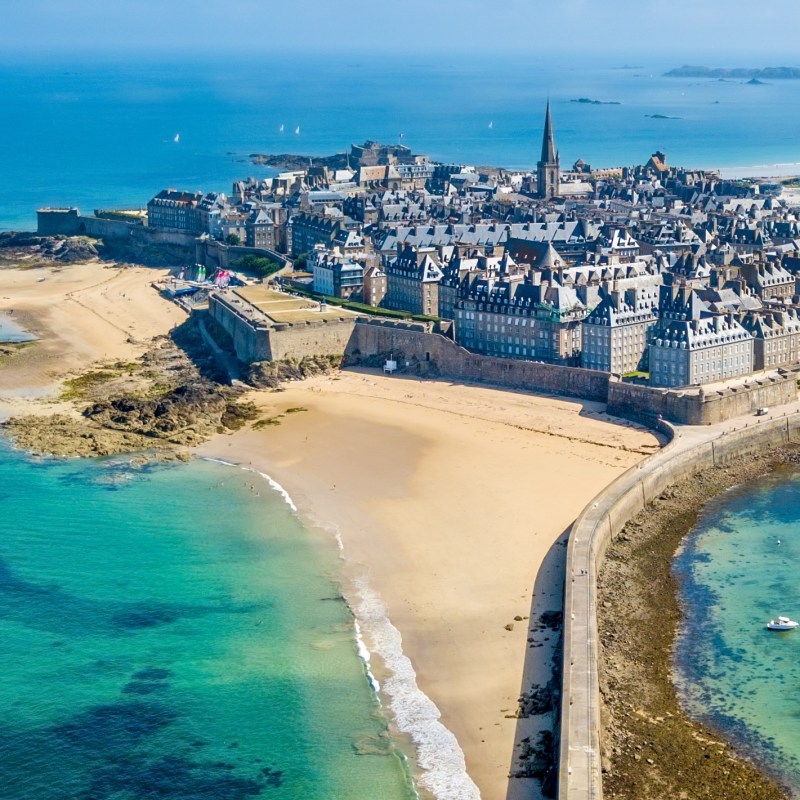
Note: The Travel Awaits team regularly updates content to provide the latest, and most accurate information to our readers. The updated content in this article may not reflect the views or opinions of the original author.
Videos by TravelAwaits
Saint-Malo is a city on the French Brittany coast, famed for once being the home of the corsairs and its enormous tidal range. The city has a walled old part called Intra Muros, within the walls, which is crammed full of historical sights and atmospheric lanes.
Set mostly within the ramparts of this old city, the Pulitzer Prize-winning book All the Light We Cannot See by Anthony Doerr takes full advantage of a locale where times seem to have stood still. Everything in the book comes alive: Marie-Laure’s story, the affection of two teenagers during World War II, the French Resistance, allied forces… everything…
The book’s story takes place during World War II and tells the tale of a young, blind French girl called Marie-Laure, who escaped Paris with her father to shelter in Saint-Malo, and a German boy of similar age called Werner, whose just-as-haunting experiences of the World War II are set against those of the girl.
As the story is told from the perspective of a blind person, the descriptions of the places are even more important, and the entire walled city of Saint-Malo is brought to life superbly by the author, so much so that even if you haven’t visited, you feel that you know your way around.
Visiting, though, is even better: You can follow in Marie-Laure’s footsteps and see the sights she experienced through touch, sound, smell, and even taste.
To prepare, read, or re-read the book so that it is fresh in your mind as you step through the fortified gates and back in time in Saint-Malo. If you are still reading, I will try not to give too much away as I share these special Saint-Malo sites.

All the Light We Cannot See in St Malo France – Guide to a Memorable Visit
4 Rue Vauborel
This is the address of the house in which Marie-Laure and her father seek shelter with Marie-Laure’s reclusive great-uncle Etienne LeBlanc and his housekeeper Madame Manec in All the Light We Cannot See. Six floors tall with an all-important attic, it should be easy to find. On the northwestern end of the walled city, close to the Bastion Saint-Philipe and the long path out to the lighthouse Phare Mole des Noires, lies the narrow Rue Vauborel. Alas, while the house number exists, the exact house is very much in the author’s imagination. But you can certainly see where he got his inspiration; the tall buildings are unique and typical of Saint-Malo’s Intra Muros.
Pro Tip: Did you know that in medieval times, the wealthiest citizens lived in the heart of walled Saint-Malo, whereas today everybody wants a sea-view home?

Entrance To The Beach
Steps away from Rue Vauborel lies the Poterne D’Estrees, the gate that leads from the road through the ramparts to the beach. Madame Manec shows Marie-Laure the way and Marie-Laure experiences the ocean, the coast, the roar of the waves, and the smell of the sea for the first time. She touch-explores the tidal pools and collects shells, which her Uncle Etienne teaches her more about.
In the chapter entitled “The Rounds,” Marie-Laure’s way from the house to the beach reads like this: “Twenty-two paces to the intersection with the Rue d’Estrees. Forty more to the little gate. Nine steps down and she’s on the sand and the twenty thousand sounds of the ocean engulf her.”
Pro Tip: The beach is a lovely place for sunset.

The Island Of Grand Be
Whenever Marie-Laure and Madame Manec go to the beach, they sit close to the Island of Grand Be, one of two tidal islands that are exposed and accessible at low tide. Grand Be houses the tomb of Saint-Malo-born writer Francois-Auguste-Rene de Chateaubriand.
Pro Tip: Do walk out to the island at low tide, but make sure you return in good time as the tidal range here is nearly 40 feet, and the water comes in fast.

Fort National On The Island Of Petit Be
While you are exploring the two tidal islands at low tide, arrange a tour of the Fort National, which was, in the book and in real life, a prison under German occupation. Reportedly, in August 1944, 380 locals were locked up by the Germans, without food, for six days. You can only enter as part of a tour, and the history lesson ties in nicely with your retracing of Marie-Laure’s steps through this French town.
Pro Tip: Plan your visit such that it coincides with low tide.

Cathedral Of Saint-Malo
The chapter entitled “In the Attic” begins, “For all of Marie-Laure’s four years in Saint-Malo, the bells at St. Vincent’s have marked the hours. But now the bells have ceased.” The Cathedral of Saint-Malo in the Parish of Saint Vincent within Intra Muros, is in fact, the church of St. Vincent. Dating back to the 1100s, the steeple of the church was bombed and damaged in WWII, quieting the bells.
Pro Tip: Inside the cathedral, you can find the tomb of local Jacques Cartier, who “discovered” Canada.

The Locked Grotto
This secret cave full of snails, set right in the ramparts (and whose key Marie-Laure was entrusted with by Crazy Hubert Bazin), really is quite a magical place. Difficult to find, it truly is a hidden grotto. Just behind the current Hotel Les Chiens du Guet, which translates as Hotel The Watchdogs, next to a larger red door, lies the small entrance to the grotto, locked by a metal gate.
The Bastion de la Hollande was built in the late 1600s in the same spot and was guarded by 24 English Mastiffs, who were let loose in the old town each night and whose kennel was in the grotto.
Pro Tip: Go up from this spot to the ramparts to read the historical marker and see the canons left over from the Bastion.

The Bakery
“Twenty-two paces down the Rue Vauborel. Then right for sixteen storm drains. Turn left on the rue Robert Surcouf. Nine more drains to the bakery.“ Sounds straightforward, but in the real Saint-Malo, it is not that easy. Trying to find the bakery that plays such an important role in All the Light We Cannot See is impossible without a house number or an actual boulangerie still in its place. It could have been the place that is now a piercing parlor, or where the pizzeria now is. That’s fiction for you.
Pro Tip: Do not fret for too long; just around the corner on Rue Broussais lies the quirky Cargo Culte, a cafe cum antiques shop, a perfect place to stop for a lunch and a coffee before heading onward.

Place Chateaubriand
Saint-Malo’s largest square, right at the main entrance to the walled city, is mentioned regularly throughout the book, be it when Marie-Laure and her father arrive, when they sit and watch the Germans drive in, as the place where the posters calling for the surrender of all firearms are displayed on the ancient trees, or as part of the daily route Madame Manec takes around the neighborhood.
The square is perfect for people-watching and is incredibly impressive, with the Chateau de Saint-Malo towering over it and the pretty Hotel Chateaubriand to the side. Alas, it is a parking lot as well, but you can simply imagine the scene from the book’s chapter “Etienne:” “Sunlight flashes from the hood ornaments and chrome fittings as the little procession grinds to a stop on the ringed gravel drive in front of the soaring lichen-streaked walls of the Chateau de Saint-Malo.”
Pro Tip: Climb up to the top of the tower in the castle for superb views across the roofs.

The Hotel Of Bees
Werner had been surviving for four days under the rubble of his hideout, the Hotel of Bees, when he first hears the radio transmission of Marie-Laure, thinking he is delirious. The Hotel of Bees, which was described as having bright-blue shutters and selling ice cream in its cafe, sadly does not exist in Saint-Malo. That said, it was located on Rue de la Crosse, as is the Hotel Porte St Pierre, with its restaurant opposite, selling, among other things, ice cream. So, with a little bit of imagination, this will do nicely.
Pro Tip: The hotel is a simple, low-cost option if you are looking for a place to stay. Ask for a sea-view room on the upper floors, which looks out across the ramparts with unparalleled views of the islands and the ocean.
I hope you enjoy following in the footsteps of Marie-Laure in Saint-Malo, reliving this amazing book in an amazing setting. Spending the night? Here are my recommendations for how to spend a perfect day in Saint-Malo.
Mémorial 39-45
The German garrison in the novel was stationed at the Cité d’Alet, a neighboring peninsula whose 18th-century fort Hitler appropriated into his Atlantic Wall. Today this group of German bunkers is a museum that opens seasonally, called the Mémorial 39-45. From beneath the blockhouse some tunnels extend for nearly a mile although they are completely off-limits.
German-Italian forces were also concentrated on the island of Cézembre before they surrendered after the napalm bombings. Nowadays most of the island remains mostly inaccessible due to the presence of mines.
The Sea
While the main attraction of Saint-Malo firmly remains its walled citadel, throughout the novel, the sea represents a safe place where the characters can escape the harsh realities of World War II and absorb the wonders of nature.
The first thing Werner does when he arrives in Saint-Malo is to run to the sea even though the beach is scattered with mines. On the other hand, when Marie-Laure arrives in Saint-Malo, she begs to go to the sea and finally gets her wish.
It’s no wonder that Saint-Malo seems to be the gem in Brittany’s crown. On sunny days, few places can rival the allure of Saint-Malo’s beaches.
FAQs
Why Is Saint-Malo Important in ‘All the Light We Cannot See’?
The beautiful port city of Saint-Malo, France is essential to the ‘All the Light We Cannot See’ novel as it wouldn’t be the same story without it. This historic seaside town in Brittany is the setting for the 2014 Anthony Doerr’s Pulitzer Prize-winning novel.
How Much Time Do You Need in Saint-Malo?
You could easily explore most of what the old town has to offer in one full day because Saint Malo is very walkable. A 2 km walk around the ramparts of Saint-Malo is one of the great urban walks of France.
Where to Stay in Saint-Malo?
It is best to stay in Intra Muros or very close to it when visiting Saint-Malo. From a traveler’s point of view at least, it is the most important side of the town and where everything happens.
Which Places in Saint-Malo retained the appearance of Saint-Malo in All the Light We Cannot See by Anthony Doerr?
La rue Chateaubriand Street and Hotel Chateaubriand. What we see today in Saint-Malo is a reconstructed town that was planned to be as close to the original as possible. Million tons of rubble were used to rebuild much of the town after World War II.
What Other Cities Are Depicted in Doerr’s ‘All the Light We Cannot See’?
The three main cities in which the novel takes place are Essen, Paris, and Saint-Malopr. They provide an evocative backdrop for the events of the novel that it’s impossible not to want to know these places better.
